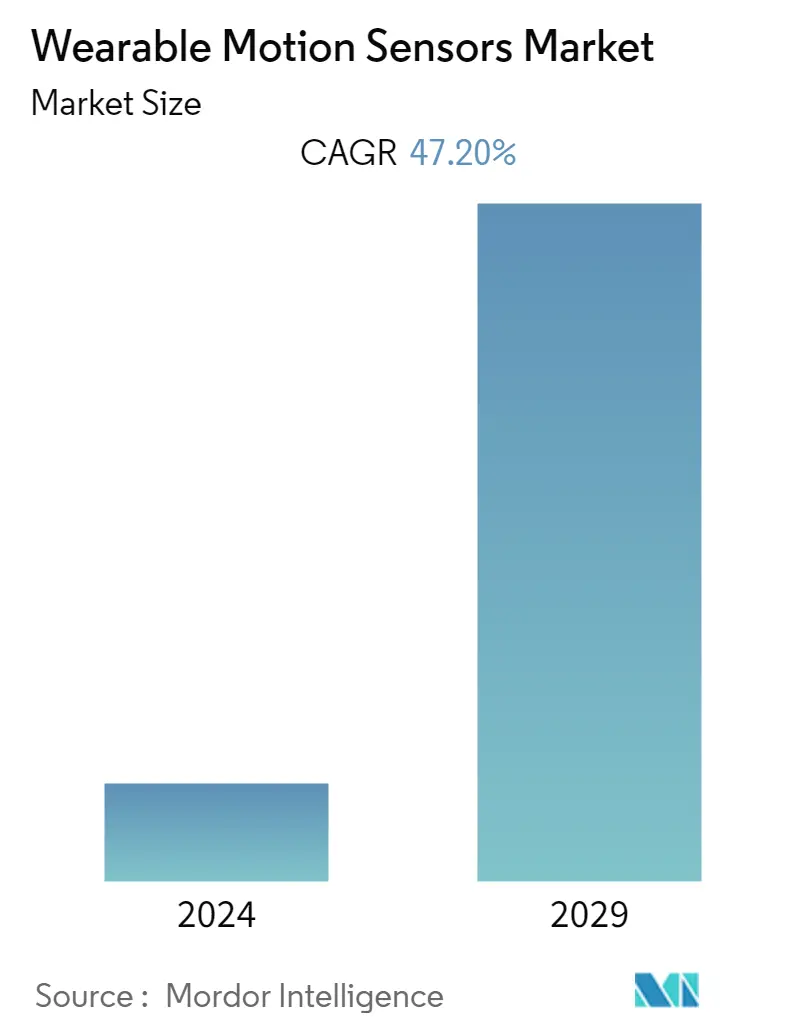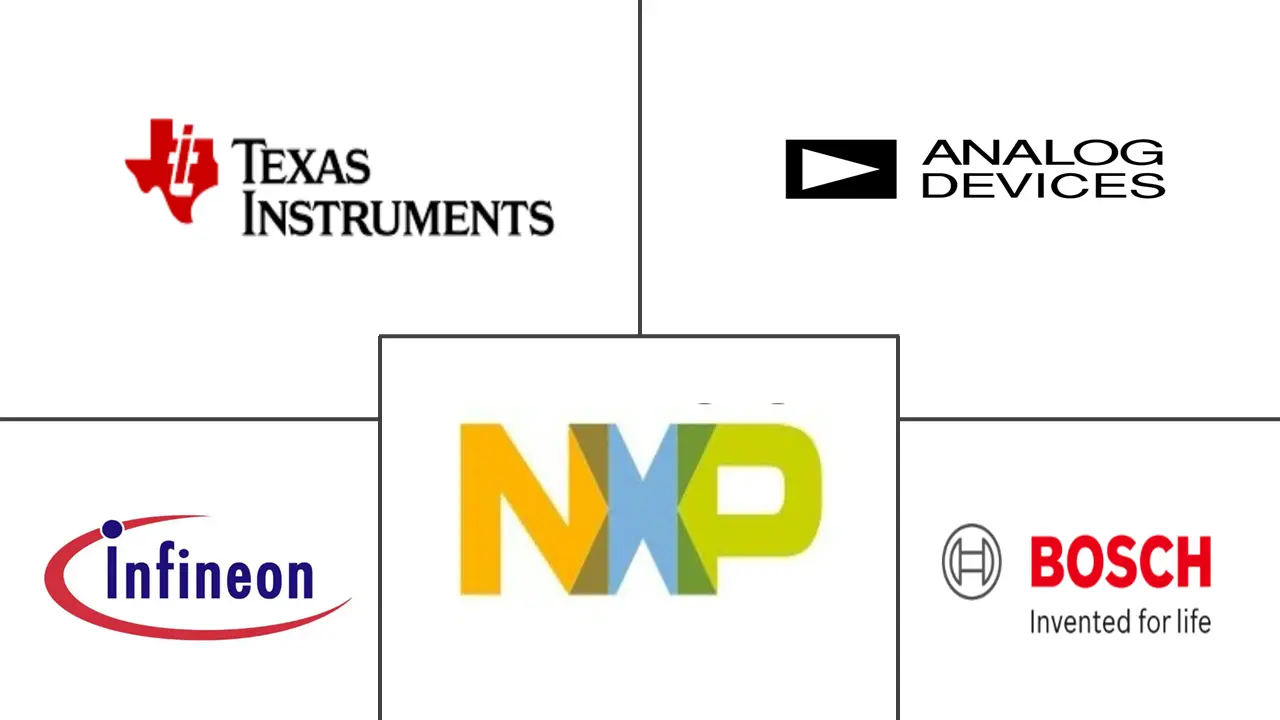Market Size of Wearable Motion Sensors Industry

| Study Period | 2019 - 2029 |
| Base Year For Estimation | 2023 |
| CAGR | 47.20 % |
| Fastest Growing Market | Asia Pacific |
| Largest Market | North America |
| Market Concentration | Low |
Major Players
*Disclaimer: Major Players sorted in no particular order |
Wearable Motion Sensor Market Analysis
The Wearable Motion Sensors Market is expected to register a CAGR of 47.2% during the forecast period. Wearable products are expected to deliver valuable services to the owners to help drive a better lifestyle. Specifically, the wrist-worn wearable market requires OEMs to provide wellness and fitness-related services, a key reason the market traction for these devices is increasing quickly. Wearable devices with embedded motion sensors are used to enrich user experience in health and fitness by tracking an individual's physical activities, such as walking, running, and cycling.
- Motion sensors, such as gyroscopes, accelerometers, Microelectromechanical Systems (MEMS), and a combination of these sensors, are the most used type of wearables. Furthermore, health-tracking wearables always integrate motion and MEMS sensors but are not limited to and can also include health-specific sensors, like heart rate monitors, skin temperature sensors, and pulse monitors.
- The market for wearable motion sensors is being driven by the shrinking of sensors and related sensor components, increasing demand for sophisticated function sensors in wearable technology, advancements in battery size and efficiency.
- Due to consumers' increased interest in tracking real-time motion sensing activities, such as step counting and walking distance covered, sensors are an essential part of wearable devices used by consumers. The analysis of the generated data gives users specific results that can be used to define health and fitness goals.
- In particular, wearable motion sensors offer great potential for health-promoting interventions in the older population, patient care and research, and geriatric rehabilitation. Continuous health monitoring and integrated diagnostic devices worn on the body can help to identify and prevent early manifestations of age-related functional decline and disease.
- The COVID-19 pandemic positively impacted the wearable motion sensors market and highlighted the need to harness and leverage the digital infrastructure for remote patient monitoring. As current viral tests and vaccines are slow to emerge, there is a need for more robust disease detection and tracking of individual and population health, which wearable motion sensors could aid.
Wearable Motion Sensor Industry Segmentation
A motion sensor detects the movement of a human being or an object concerning the external environment. A wearable motion sensor may track a person's movement and record the information, which can then be analyzed. It records a person's movements using gyroscopes and accelerometers.
The Wearable Motion Sensors Market is segmented by Type (Accelerometers, Inertial Gyroscopes, MEMS), by Application (Smart Watches, Fitness Bands, Activity Monitors, Smart Clothing, Sports Gear), by End-user Industry (Healthcare, Sports/Fitness, Consumer Electronics, Entertainment and Media, Government and Public Utilities), and by Geography (North America (United States, Canada), Europe (Germany, United Kingdom, Italy, France, and Rest of Europe), Asia-Pacific (China, Japan, India, and Rest of Asia-Pacific), Latin America (Brazil, Argentina, and Rest of Latin America), and Middle East and Africa (United Arab Emirates, Saudi Arabia, and Rest of Middle East & Africa)). The market sizes and forecasts are provided in terms of value (USD million) for all the above segments.
| By Type | |
| Accelerometers | |
| Inertial Gyroscopes | |
| MEMS |
| By Application | |
| Smart Watches | |
| Fitness Bands | |
| Activity Monitors | |
| Smart Clothing | |
| Sports Gear |
| By End-user Industry | |
| Healthcare | |
| Sports/Fitness | |
| Consumer Electronics | |
| Entertainment and Media | |
| Government and Public Utilities |
| By Geography | ||||||
| ||||||
| ||||||
| ||||||
| ||||||
|
Wearable Motion Sensors Market Size Summary
The wearable motion sensor market is poised for substantial growth, driven by the increasing integration of advanced sensors like gyroscopes, accelerometers, and MEMS into consumer devices. These sensors enhance user experiences by enabling health and fitness tracking, such as monitoring physical activities and vital signs. The demand for smaller, more sophisticated sensors and improvements in battery technology are key factors propelling market expansion. Wearable motion sensors are particularly valuable in health-promoting applications for older adults, patient care, and geriatric rehabilitation, offering continuous monitoring and early disease detection. The COVID-19 pandemic has further accelerated market growth by highlighting the importance of remote health monitoring solutions.
The Asia-Pacific region is expected to experience significant market growth due to rapid urbanization and increased awareness of wearable technologies. This region is home to major sensor and semiconductor manufacturers, contributing to the market's expansion. Companies in countries like Japan and China are heavily investing in sensor technology advancements, driven by the popularity of wearable fitness and health tracking devices. The competitive landscape of the wearable motion sensor market is characterized by the presence of both large and small players, with major companies focusing on expanding their global consumer base through partnerships and product innovations. Recent collaborations and technological advancements, such as those by Analog Devices and Qeexo, highlight the ongoing efforts to enhance the functionality and efficiency of wearable motion sensors across various applications.
Wearable Motion Sensors Market Size - Table of Contents
-
1. MARKET INSIGHTS
-
1.1 Market Overview
-
1.2 Industry Attractiveness - Porter's Five Forces Analysis
-
1.2.1 Bargaining Power of Suppliers
-
1.2.2 Bargaining Power of Consumers
-
1.2.3 Threat of New Entrants
-
1.2.4 Threat of Substitutes
-
1.2.5 Intensity of Competitive Rivalry
-
-
1.3 Impact of COVID-19 on the Wearable Motion Sensors Market
-
-
2. MARKET SEGMENTATION
-
2.1 By Type
-
2.1.1 Accelerometers
-
2.1.2 Inertial Gyroscopes
-
2.1.3 MEMS
-
-
2.2 By Application
-
2.2.1 Smart Watches
-
2.2.2 Fitness Bands
-
2.2.3 Activity Monitors
-
2.2.4 Smart Clothing
-
2.2.5 Sports Gear
-
-
2.3 By End-user Industry
-
2.3.1 Healthcare
-
2.3.2 Sports/Fitness
-
2.3.3 Consumer Electronics
-
2.3.4 Entertainment and Media
-
2.3.5 Government and Public Utilities
-
-
2.4 By Geography
-
2.4.1 North America
-
2.4.1.1 United States
-
2.4.1.2 Canada
-
-
2.4.2 Europe
-
2.4.2.1 United Kingdom
-
2.4.2.2 Germany
-
2.4.2.3 France
-
2.4.2.4 Rest of Europe
-
-
2.4.3 Asia Pacific
-
2.4.3.1 China
-
2.4.3.2 Japan
-
2.4.3.3 India
-
2.4.3.4 Rest of Asia Pacific
-
-
2.4.4 Latin America
-
2.4.4.1 Brazil
-
2.4.4.2 Argentina
-
2.4.4.3 Rest of Latin America
-
-
2.4.5 Middle East and Africa
-
2.4.5.1 United Arab Emirates
-
2.4.5.2 Saudi Arabia
-
2.4.5.3 Rest of Middle East & Africa
-
-
-
Wearable Motion Sensors Market Size FAQs
What is the current Wearable Motion Sensors Market size?
The Wearable Motion Sensors Market is projected to register a CAGR of 47.20% during the forecast period (2024-2029)
Who are the key players in Wearable Motion Sensors Market?
Texas Instruments Incorporated, Analog Devices Inc., Infineon Technologies AG, NXP Semiconductors and Bosch Sensortec GmbH are the major companies operating in the Wearable Motion Sensors Market.

